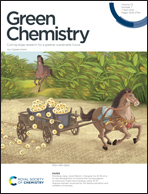γ-Valerolactone-introduced controlled-isomerization of glucose for lactic acid production over an Sn-Beta catalyst†
Abstract
Combined experiments and density functional theory (DFT) calculations provided insights into the role of environment-friendly γ-valerolactone (GVL) as a solvent in the hydrothermal conversion of glucose into lactic acid (LA) over the post-synthesized Sn-Beta catalyst. By introducing 2.0 wt% GVL, a much higher yield of LA (72.0 wt%) was obtained than that in pure water (60.1 wt%) at 200 °C, 4 MPa N2, and 30 min in a batch reactor. The GVL effectively suppressed the isomerization of glucose into fructose in a controlled-transfer mode, resulting in a lower fructose concentration. Thermogravimetry-differential analysis and DFT calculations demonstrated that the competitive adsorption between GVL and glucose happened at the open Sn sites over the Sn-Beta catalyst, which led to a controlled isomerization rate in water. Further increasing the content of GVL to 20.0 wt%, the higher yield of LA (74.0 wt%) was attributed to the more efficient competitive adsorption while also inhibiting carbon deposition.



 Please wait while we load your content...
Please wait while we load your content...